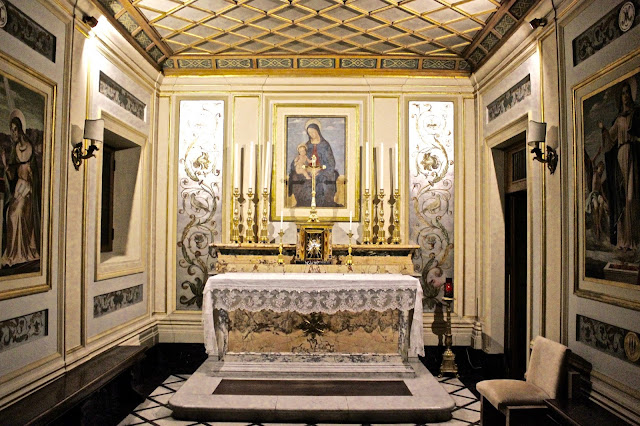The Capranica, a Renaissance palazzo and a seminary.
I have recently visited a very secret place, usually not accessible to the public, the seminary of the Roman Catholic diocese of Rome: the Almo Collegio Capranica. This ancient institution happens to be housed in a Renaissance palazzo which still preserves some of its late Medieval charm.
The Palazzo in the 19th century
In 1457 Cardinal Domenico Capranica founded a college (a seminary) where those who could not afford to train as priests could finally do so, this was part of a series of initiatives of the Quattrocento Rome that should change our view of the Renaissance, shaped by too many inaccurate films and tv-series, these included the restoration of hospitals (such as Santo Spirito in Saxia) and much more, of course this does not sell as much as violence or explicit sex! However, I believe it is a good sign of how the beauty of arts does not necessarily deprive common people from more concrete necessities, but let us get back to the college!
The Arch-Confraternity coat of arms
The aim of the college and of its founder was that of training clergy both culturally and spiritually, as for many other institutions the Cardinal gave the college financial help, so that the men of God would not be too concerned about the most vulgar part of the secular world. In 1459 the college opened its doors to some thirty students, the institution was entrusted to the Arch-Confraternity of the SS. Salvatore of the Sancta Sanctorum of which the cardinal himself was part since 1452. In 1478 Domenico's brother, Angelo (another cardinal) obtained a license from Pope Sixtus IV for the building of a specific college palazzo, next to the ancient Palazzo Capranica, near Santa Maria in Aquiro. The family had the right of choosing the candidates, although the administrative and religious functions were still taken by the Arch-Confraternity.
The title almo ("which gives life") is a reminder of those students and superiors who gave their lives for the college and the Supreme Pontiff during the Sack of Rome of 1527 near the Porta Santo Spirito. The library of the Capranica cardinals was donated to the college after their death, now most manuscripts are conserved in the Vatican Library.
The façade of the palazzo
The college is still located in that Renaissance palazzo, a unique testimony in an area of Rome so dense of Baroque architecture, the main façade, on the piazza, features a very common scheme of the 15th century, on the left hand of the building is a squared tower that ends in a small loggia, on the bottom of it is the coat of arms of the Arch-Confraternity: the head of Jesus with two candle-sticks and people at prayer. The two entrances to the palazzo have Renaissance style door frames, while the piano nobile has three Gothic windows and three Renaissance cross-shaped ones. Another floor was added in the 1600s.
The façade of the palazzo
The inside of the beautiful palazzo is very similar to one of the several Roman princely homes, I decided not to take photos of the corridors for privacy reasons. However, the most fascinating works in the palazzo are from the 15th century and it is a series of frescoes by the greatest artist of the Roman Renaissance Antoniazzo Romano, famous for his works in Santa Maria sopra Minerva and Tor de' Specchi.
Detail of the Madonna and Child in the main chapel
The first series of frescoes we encounter is the Sala degli Affreschi - a small room decorated with the shields of the noble Roman families. The small room used to be a refectory, but during the 1950s a series of frescoes was found under the whitewashed walls in the lunettes created by the late Medieval ceiling. The frescoes are from Antoniazzo Romano's workshop and represent the Crucifixion with two saints and the two donors. One of the saints is Saint Agnes, patron of the college.
The Sala degli Affreschi, a Renaissance room
The fresco
Bishop with donor
Crucifixion
Saint Agnes with donor
On the Piano Nobile we find a big room, the Salone d'Onore, which is also a sort of narthex to the college chapel, here we find another small fresco by Antoniazzo Romano, a crucifixion with Saint Agnes and St. John the Baptist.
Crucifixion with Saint Agnes and St. John the Baptist
The chapel was sadly "renovated" during the 20th century, what is left though is another wonderful fresco by Antoniazzo, an altarpiece representing an enthroned Madonna and Child surrounded by Saint Agnes and a bishop with the two donors. Interestingly enough the bishop is holding an idealised replica of the original college and Saint Agnes is holding a sacrificial lamb.
Madonna and Child with bishop, Saint Agnes (patron) and donors.
The college has also a smaller chapel, the Cappellina dell'Assunta (the chapel of the Assumption of Mary), this cozy space hosts the original high altar of the main chapel as well as a small altarpiece by Antoniazzo Romano.
The Assunta Chapel
Antoniazzo Romano's Madonna and Child in the Assunta Chapel
Despite the modifications it is still possible to go back in time in this ancient building, I am glad you will be able to see the little jewels this place has to offer, I hope I made an inaccessible place, accessible!















